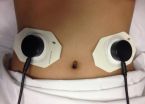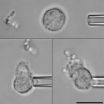(Press-News.org) Washington, DC (August 7, 2014) — A new tool that takes multiple factors into account can accurately predict how likely a patient who experienced a painful kidney stone will develop another one in the future. The tool, which is described in an upcoming issue of the Journal of the American Society of Nephrology (JASN), could help patients and their doctors determine whether preventive measures are needed.
Kidney stones are common and affect approximately 6% to 9% of the population. The greatest concern of patients who have experienced a kidney stone is whether this excruciating painful event will ever happen again. Certain dietary recommendations and medications can help prevent another kidney stone from forming, but these can be burdensome, expensive, or cause side effects. "If we knew which patients were at high risk for another symptomatic kidney stone, then we could better advise patients on whether to follow stone prevention diets or take medications," said Andrew Rule, MD (Mayo Clinic). "At the same time, patients who are at low risk of having another kidney stone may not need restrictive diets and medications."
Dr. Rule and his colleagues conducted a study to help them develop a prediction tool that could be used by patients and their doctors to determine the risk of having a second symptomatic kidney stone after the first. The team reviewed the medical records of all adult first-time symptomatic stone formers residing in Olmsted County, Minnesota, from 1984 to 2003. Of the 2239 individuals identified, 707 experienced a recurrence through 2012.
From the information they gathered, the researchers developed the Recurrence of Kidney Stone (ROKS) nomogram that uses 11 questions about the patient to accurately calculate the probability of having another symptomatic kidney stone at 2, 5, or 10 years after the first stone. Characteristics that predict a higher risk include younger age, male gender, white race, family history of kidney stones, blood seen in the urine, stone made of uric acid (rather than calcium), obstructing stone in the kidney pelvis, any additional non-obstructing stone, and any past painful event attributed to a kidney stone even though a stone was not seen.
In an accompanying editorial, Brian Eisner, MD (Massachusetts General Hospital and Harvard Medical School) and David Goldfarb, MD (York Harbor VA Healthcare System and NYU School of Medicine) noted that for the nomogram to demonstrate value, it now should be tested prospectively in additional populations of stone formers. "Whether additional variables can be added to increase the usefulness of this tool will be of interest in the future," they added.
INFORMATION:
The nomogram is available on the Internet at http://www.qxmd.com/calculate-online/nephrology/recurrence-of-kidney-stone-roks.
Study co-authors include John Lieske, MD, Xujian Li, MS, L Joseph Melton III, MD, Amy Krambeck, MD, and Eric J Bergstralh, MS.
Disclosures: The study was accomplished though the Mayo Clinic O'Brien Urology Research Center that is funded by the National Institute of Diabetes and Digestive and Kidney Diseases.
The article, entitled "The ROKS Nomogram for Predicting a Second Symptomatic Stone Episode," will appear online at http://jasn.asnjournals.org/ on August 7, 2014.
The editorial, entitled, "A Nomogram for the Prediction of Kidney Stone Recurrence," will appear online at http://jasn.asnjournals.org/ on August, 7, 2014.
The content of this article does not reflect the views or opinions of The American Society of Nephrology (ASN). Responsibility for the information and views expressed therein lies entirely with the author(s). ASN does not offer medical advice. All content in ASN publications is for informational purposes only, and is not intended to cover all possible uses, directions, precautions, drug interactions, or adverse effects. This content should not be used during a medical emergency or for the diagnosis or treatment of any medical condition. Please consult your doctor or other qualified health care provider if you have any questions about a medical condition, or before taking any drug, changing your diet or commencing or discontinuing any course of treatment. Do not ignore or delay obtaining professional medical advice because of information accessed through ASN. Call 911 or your doctor for all medical emergencies.
Founded in 1966, and with more than 14,000 members, the American Society of Nephrology (ASN) leads the fight against kidney disease by educating health professionals, sharing new knowledge, advancing research, and advocating the highest quality care for patients.
New test predicts individual's risk of a second kidney stone
Results may help determine whether preventive measures are needed
2014-08-08
ELSE PRESS RELEASES FROM THIS DATE:
Boston Marathon bombing caregivers still grappling with tragedy one year later
2014-08-08
Boston, MA (August, 2014) – Nearly a year after the 2013 Boston Marathon bombings, hospital staff, first responders and medical volunteers who cared for the injured and dying were still struggling to put the experience behind them, according to a Schwartz Center for Compassionate Healthcare report that describes eight confidential sessions held to help caregivers process their emotions and feelings in the aftermath of this horrific event.
The 90-minute Schwartz Center Rounds sessions – sponsored by the Schwartz Center in collaboration with the Conference of Boston Teaching ...
Slowing brain functions linked to increased risk of stroke, death
2014-08-07
Cognitive abilities such as memory and attention are not only important after a stroke but also before; according to research published in the American Heart Association journal Stroke.
Previous studies have shown poor cardiovascular health can increase the risk of cognitive impairment such as problems in memory and learning. However, the opposite idea that cognitive impairment may impact cardiovascular health, specifically stroke, was not established before.
"Most clinical studies observe cognitive impairment after a stroke event, said Kumar Rajan, Ph.D., lead author ...
Neck manipulation may be associated with stroke
2014-08-07
Treatments involving neck manipulation may be associated with stroke, though it cannot be said with certainty that neck manipulation causes strokes, according to a new scientific statement published in the American Heart Association's journal Stroke.
Cervical artery dissection (CD) is a small tear in the layers of artery walls in the neck. It can result in ischemic stroke if a blood clot forms after a trivial or major trauma in the neck and later causes blockage of a blood vessel in the brain. Cervical artery dissection is an important cause of stroke in young and middle-aged ...
New treatment successful for the Mal de Debarquement Syndrome
2014-08-07
People who suffer from a rare illness, the Mal de Debarquement Syndrome (MdDS), now have a chance for full recovery thanks to treatment developed by researchers at the Icahn School of Medicine at Mount Sinai. Their findings were published online in the July issue of Frontiers in Neurology.
People often feel a sensation of movement, called Mal de Debarquement, after they have finished boating, surfing or a sea voyage. The symptoms usually disappear within hours, but in some people, and more frequently in women, symptoms can continue for months or years, causing fatigue, ...
Northwest Territories on fire and smoke drifts over Labrador Sea
2014-08-07
The fires on the shores of the Great Slave Lake in the Northwest Territories in Canada do not seem in any hurry to be extinguished. In this natural-color satellite image which was collected by the Moderate Resolution Imaging Spectroradiometer (MODIS) aboard the Aqua satellite on July 29, 2014 dozens of fires and copious amounts of smoke are evident. Actively burning areas, detected by MODIS's thermal bands, are outlined in red.
Click on the image above and an image of smoke drifting over the Labrador Sea appears. This smoke has risen off the fires in the Northwest Territories ...
Laparoscopic surgical removal of the gallbladder in pediatric patients is safe
2014-08-07
ROCHESTER, Minn. — A recent study conducted by Mayo Clinic researchers recommends laparoscopic cholecystectomies (surgical removal of the gallbladder) for pediatric patients suffering from gallstones and other gallbladder diseases. This study was published in Surgical Laparoscopy Endoscopy & Percutaneous Techniques.
MULTIMEDIA ALERT: Video and audio are available for download on the Mayo Clinic News Network.
A cholecystectomy is a surgical procedure performed to remove the gallbladder, a pear-shaped organ located below the liver on the upper right side of the abdomen. ...
New disposable biosensor may help physicians determine which patients can safely be fed following surgery
2014-08-07
A disposal, plastic listening device that attaches to the abdomen may help doctors definitively determine which post-operative patients should be fed and which should not, an invention that may improve outcomes, decrease healthcare costs and shorten hospital stays, according to a UCLA study.
Some patients who undergo surgery develop a condition called post-operative ileus (POI), a malfunction of the intestines. The condition causes patients to become ill if they eat too soon, which can lengthen an affected patient's hospital stay by two to three days. Until now, there ...
Team determines structure of a molecular machine that targets viral DNA for destruction
2014-08-07
BOZEMAN, Mont. – With a featured publication in the Aug. 7 issue of Science, Montana State University researchers have made a significant contribution to the understanding of a new field of DNA research, with the acronym CRISPR, that holds enormous promise for fighting infectious diseases and genetic disorders.
The MSU-led research provides the first detailed blueprint of a multi-subunit "molecular machinery" that bacteria use to detect and destroy invading viruses.
"We generally think of bacteria as making us sick, but rarely do we consider what happens when the ...
Expert insights on in vitro alternatives for drug and chemical toxicity testing
2014-08-07
New Rochelle, NY, August 7, 2014—In vitro toxicity testing is rapidly being adopted in the pharmaceutical, chemical, and cosmetics industries, for example, as an alternative to animal studies to predict adverse health effects of drugs and personal care products and the health consequences of environmental exposures. An insightful Roundtable Discussion focused on how to apply these novel toxicology models to everyday hazard prediction, risk assessment, and decision making in industry is published in the preview issue of the new journal Applied In Vitro Toxicology, a peer-reviewed ...
The typhoid fever pathogen uses a cloaking mechanism to evade neutrophil neutralization
2014-08-07
Typhoid fever is caused by systemic (body-wide) infection with Salmonella enterica Typhi. In contrast, infection with the closely related bacterium Salmonella enterica Thyphimurium is usually limited to the gut and causes less serious diarrheal disease. Research published on August 7th in PLOS Pathogens comparing the two pathogens reveals how S. Typhi avoids recognition and elimination by patrolling immune cells called neutrophils, allowing it to disseminate throughout the patient's body.
Neutrophils track down microbial invaders and gobble them up. To investigate why ...
LAST 30 PRESS RELEASES:
Making lighter work of calculating fluid and heat flow
Normalizing blood sugar can halve heart attack risk
Lowering blood sugar cuts heart attack risk in people with prediabetes
Study links genetic variants to risk of blinding eye disease in premature infants
Non-opioid ‘pain sponge’ therapy halts cartilage degeneration and relieves chronic pain
AI can pick up cultural values by mimicking how kids learn
China’s ecological redlines offer fast track to 30 x 30 global conservation goal
Invisible indoor threats: emerging household contaminants and their growing risks to human health
Adding antibody treatment to chemo boosts outcomes for children with rare cancer
Germline pathogenic variants among women without a history of breast cancer
Tanning beds triple melanoma risk, potentially causing broad DNA damage
Unique bond identified as key to viral infection speed
Indoor tanning makes youthful skin much older on a genetic level
Mouse model sheds new light on the causes and potential solutions to human GI problems linked to muscular dystrophy
The Journal of Nuclear Medicine ahead-of-print tip sheet: December 12, 2025
Smarter tools for peering into the microscopic world
Applications open for funding to conduct research in the Kinsey Institute archives
Global measure underestimates the severity of food insecurity
Child survivors of critical illness are missing out on timely follow up care
Risk-based vs annual breast cancer screening / the WISDOM randomized clinical trial
University of Toronto launches Electric Vehicle Innovation Ontario to accelerate advanced EV technologies and build Canada’s innovation advantage
Early relapse predicts poor outcomes in aggressive blood cancer
American College of Lifestyle Medicine applauds two CMS models aligned with lifestyle medicine practice and reimbursement
Clinical trial finds cannabis use not a barrier to quitting nicotine vaping
Supplemental nutrition assistance program policies and food insecurity
Switching immune cells to “night mode” could limit damage after a heart attack, study suggests
URI-based Global RIghts Project report spotlights continued troubling trends in worldwide inhumane treatment
Neutrophils are less aggressive at night, explaining why nighttime heart attacks cause less damage than daytime events
Menopausal hormone therapy may not pose breast cancer risk for women with BRCA mutations
Mobile health tool may improve quality of life for adolescent and young adult breast cancer survivors
[Press-News.org] New test predicts individual's risk of a second kidney stoneResults may help determine whether preventive measures are needed



